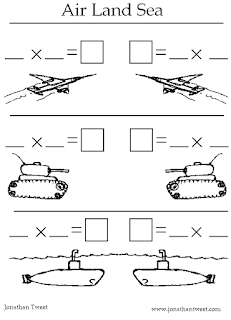 |
| Air Land Sea is my only perfect game. Also great for kids. |
Most of my adult life, my livelihood has been creating sophisticated games for adults. Some games were artsy, like Over the Edge. Others were commercial endeavors, as when I led the redesign of Dungeons & Dragons and helped revive the sagging brand. At the same time that I was creating commercial games for strangers, I was also creating free games for kids, actually for my daughter as she grew up. These projects were “for fun” games that few people have heard about. It’s something new and exciting for me to do a professional game that’s kid-friendly, and that’s what Clades is. This post describes some of my kid games that, in some way, led up to Clades.
Twenty Guesses
If you play Twenty Questions with kids, you will discover that they would rather make guesses than reframe their guesses as yes-or-no questions. So how do you play Twenty Questions with little children? Turn it into “Twenty Guesses”. Instead of trying to get little kids to form yes-or-no questions, let them do what they want to do and just makes guesses. The trick is in how the grownup with the “secret” answers the guess. The grownup gives one hint about how the guess is “right” and another about how the guess is “wrong”. This structure models abstract categorization for little children, and they get it. Here’s a hypothetical example.
Grownup: OK, I’m thinking of something. [secretly thinking “monkey”]
Kid 1: Is it a car?
Grownup: No, like a car, it can move from one place to another, but unlike a car it’s alive.
Kid 2: Is it a dog?
Grownup: It is a mammal, like a dog, but it’s not usually kept as a pet.
Kid 1: A cat!
Grownup: Remember, people don’t usually have them as pets, but they are furry and they have tails.
Kid 3: A beaver.
Grownup: It has hair and a tail like a beaver, but it doesn’t live in the water. It lives in the trees.
Kid 2: A three-toed sloth!
Grownup: Remember, it has a tail, but it does live in the jungle, like a sloth does. It jumps around a lot more than a sloth.
Kid 3: A monkey!
Grownup: Right.
For more discussion of this variant on Twenty Questions, see my web page on this game, where I called the game “Guessit”.
Spaceship
 |
| A finished game of Spaceship |
This game is the simplest way I can think of to give a quite small child real tactical choices with instant consequences, good or bad. Spaceship is a little-kid version of Air, Land, and Sea.
For more information, here’s the link to my web page on this game.
Air Land Sea
| Update: The end state of an improvised miniatures game that adapted the Air Land Sea mechanic. This is the 4-year old’s army. He tied the 10-year old. |
For more about this game, here’s my original page about it.
Clever observers might see a resemblance between the three environments in Air Land Sea, the three theaters in Richard Garfield’s Star Wars card game, and the three environments in Clades.
Princess
This simple card game was all about the central question of poker: should I put more money in and vie for the pot, or should I cut my losses and fold? This relates directly to the other important question: are they bluffing? The top card in the custom deck is the Princess, thus the name of the game. This game was not a hit, but even a failed experiment teaches you something. Maybe if I made kids actually bet money, they’d find it more engaging, but I’m not sure that’s a great idea. In creating games for grownups, Rob Heinsoo makes use of a similar tension—to vie for the pot or not—in his grownup games Three Dragon Ante and Night Eternal.
Checkers variants
Checkers is a great game for a grownup and a child to play competitively against each other. Unlike chess, the game plays perfectly well with some of the grownup’s pieces removed. This asymmetry gives the game momentum, in that the grownup starts behind but might pull ahead. Both players can try as hard as they can to win, and the grownup can increase or decrease the child’s advantage just by starting with more or fewer pieces. To keep the game from dragging on, have a player win when they have more queens than the other player has pieces (regular pieces plus crowned pieces). Since I played with my daughter, the crowned pieces were queens, and the uncrowned “men” were princesses.
Here’s my original page on checkers.
Clades, the Evolutionary Card Game
For years I’ve puzzled over how one could create an evolution game that has solid science behind it. My answer is Clades. It works by playing to kids’ natural inclination to categorize animals, and it teaches that the way to understand an animal’s place in this world is to understand its evolutionary history. Like many of the games I’ve described here, it works great when grownups play with kids. For example, since most of the cards are face-up on the table, it’s easy for a grownup to help younger players.
In 2016, artist Karen Lewis and I returned to Kickstarter to raise money for Clades, and we raised enough to produce a “dinosaur” version, Clades Prehistoric. You can play the games separately or together. Clades and Clades Prehistoric are available from Atlas Games or (better yet) from your friendly local brick-and-mortar store.
In 2016, artist Karen Lewis and I returned to Kickstarter to raise money for Clades, and we raised enough to produce a “dinosaur” version, Clades Prehistoric. You can play the games separately or together. Clades and Clades Prehistoric are available from Atlas Games or (better yet) from your friendly local brick-and-mortar store.

